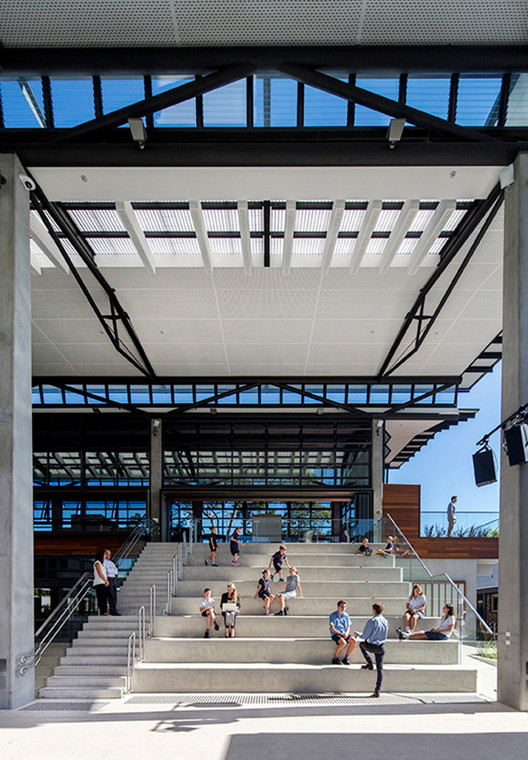
-
Architects: WMK Architecture
- Area: 4000 m²
- Year: 2015
-
Photographs:Brett Boardman, Marcus Clinton
-
Acoustics: Acoustic Studio, Peter Griffiths
-
Town Planning: Don Fox Planning, John McFadden
-
Project Manager: EPM Projects, Andrew Graham, Kathryn Cuno
-
Electrical: VOS Group, Janet Tam, Shane Mercer
-
Mechanical: VOS Group, Peter Morton
-
Civil: Woolacotts, Clare Woods

Text description provided by the architects. WMK’s latest design in educational built environments for Northern Beaches Christian School [NBCS] signals the ‘school of the future’, delivering the school’s far-reaching vision for a new learning paradigm that fosters self-directed learning.
Under a soaring 11m high, 3000m2 canopy, the notion of a classroom is superseded by indoor and outdoor collaborative spaces designed for multiple learning modes and non-hierarchical interaction.
WMK collaborated closely with Northern Beaches Christian School’s principal, Stephen Harris and leading educators to understand how the built environment could support and contribute to the new learning model that the school pioneers.

Designed environment
WMK has created an overarching canopy structure that echoes the surrounding eucalypt trees, directing light and shade, with tapered, three-storey high concrete columns and steel roof trusses supporting a stepped semi-transparent roof. The scale of the canopy and the refined use of concrete and timber in the interconnecting pavilions, ramps and bridges beneath, evokes a sense of playfulness alongside grounded strength.
Three multi-level pavilion buildings sit beneath the canopy structure in a visually dynamic environment. The pavilions accommodate interactive learning spaces, science laboratory and student support facilities, and the main reception and administration. A canteen pod building takes centre place with its ‘treehouse’ platform anchored back to the learning spaces via a bridge.
Using balconies, seating nodes, oversized steps, and timber platforms - all wired for technology – WMK has created endless configurations for performing, learning and studying, fully utilising external space under the canopy. The centrally-located cafeteria pavilion creates a meeting place for students, teachers, parents and visitors alike and an outdoor stage and large screens complete the active, adaptable heart of the school.

Sustainability
The canopy structure is also an intelligent ‘living’ structure which generates energy, harvests rainwater, and cools the spaces below. The column design reticulates rainwater to underground collection tanks and then can feed stored rainwater back up to the canopy misting system. WMK has designed for maximum use of natural light and ventilation, and windows and louvres in the building and canopy are automated to provide ventilation in direct response to climate conditions using a sophisticated Building Management System.
The sustainability initiatives incorporated throughout the new built environment deliver beyond carbon saving and economic benefits however, engaging students in monitoring the resource efficiencies including waste, and leading the ‘new normal’ through active learning.

Learning spaces
The buildings provide a careful mix of scaled spaces – from double height open learning areas that share teacher workspaces to intimate sanctuaries where small groups or individuals can work when they need a quiet space. Interestingly, WMK has designed a school environment using activity-based design principles usually developed for workspaces, with no restrictions on whether students or teachers use the space. This approach responds to important aspects of the school’s learning model wherein students are entrusted to determine their own learning space and teachers are housed in the same shared spaces.

All learning spaces have been planned to overlook the outdoor canopy area, providing a visual link into and from class activity. Students’ have their creative thinking on display in the new glazed and light-filled science lab, and this is also encouraged by the custom ‘writable’ tables, benches and walls. In the senior learning centre WMK’s innovative pod stations and custom freeform worktables have proven a favourite for group thinking, oversized chairs encourage individual thought time, while window benches might suit the focussed laptop user.
The shared environment is reinforced in built form from the top down, with Principal Stephen Harris leading a ‘no offices’ approach and locating his workspace in the midst of the teachers’ open-plan area. WMK has found that designing-in work transparency such as this, leads to increased knowledge transfer and is a key component of a healthy learning culture, bringing organisational benefits on many levels.

Leading education innovation
The school’s new buildings and structures provide a new education dimension that is not so much studying as knowledge cross-pollination in a vibrant, learning lifestyle, while still providing the guidance of a close school community. It’s still early days but students have taken instantly to the new environment, encouraged to discover favourite places to work and interact.

In a highly successful collaboration of education and built environment vision, the architectural design delivers a unique learning environment that identifies with the learning style of the next generation. Its focus is to engage young adults and re-shape our thinking about how school buildings can be used to actively promote better learning and prepare students for future work environments.














